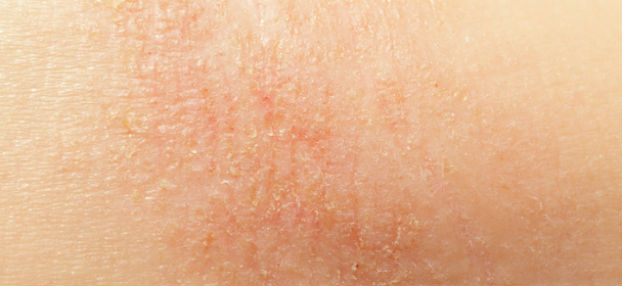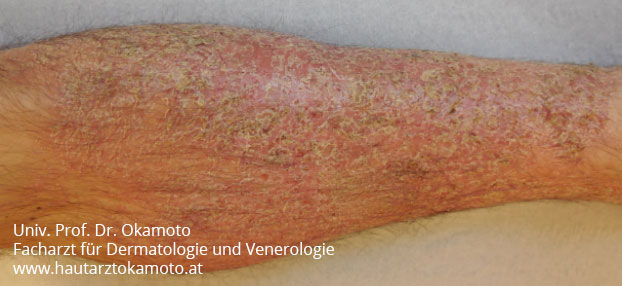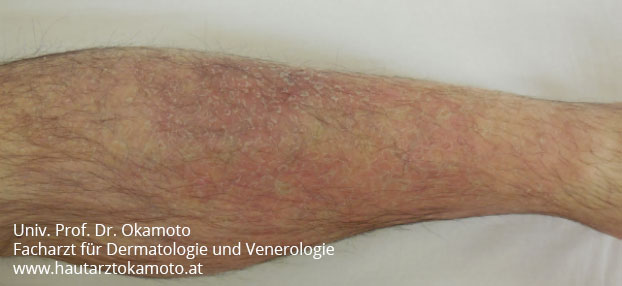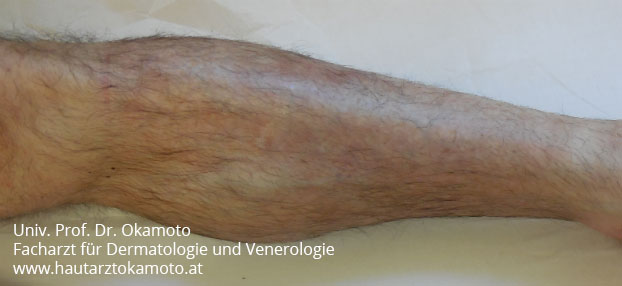Dermatologist Prof. Dr. Ichiro Okamoto explains various types of eczemas. An individual treatment optimized for the patients’ needs is required to achieve sustainable relieve from this chronic disease. Similar to allergies, eczemas can lead to other severe medical conditions if not treated properly (regarding new treatment or prevention method of pollen allergy, please visit pollen desensitization).
For arranging an appointment for treatment of eczema in Vienna, please contact our office by phone +43 1 40114/5701, email ordination@hautarztokamoto.at or use the online-form.
Information about eczema by Dermatologist Prof. Dr. Okamoto in Vienna
An eczema is commonly characterized by red, scaly plaques on the skin which can also blister. Affected areas often itch leading to sometimes severe deterioration of quality of life. Scratching even worsens the condition, leading to wounds which are not only painful but represent potential gateways for bacterial infections.

The course of the disease is typically chronic with acute phases. Even though the molecular mechanisms are not yet well defined, both, endogenous and exogenous factors (or triggers) are believed to be responsible for the outbreak of the disease.
Roughly, 3 forms of eczemas can be distinguished: toxic and allergic contact dermatitis and atopic dermatitis (also known as neurodermitis). In general, it is currently believed that the deterioration of the barrier function of the skin is of upmost importance for the development of eczemas, particularly for atopic dermatitis.
Contact dermatitis
As the name implicates, contact dermatitis appears only after direct contact with a certain material or substance. These substances can be irritant (such as acids) or cause an allergic reaction (allergic contact dermatitis). An allergic contact dermatitis can be caused for example by metals (nickel, cobalt), food and perfumes. An allergy test can reveal the substance to which someone reacts. This information is useful to prevent from allergic reaction in the future.
Atopic Dermatitis

A typical eczema (eczema craquelé) on the lower leg before therapy
Atopic dermatitis or also known as neurodermitis is rather a syndrome affecting also the eyes (conjunctivitis), nose (rhinitis) and air passages (asthma) besides skin. The skin of affected people is in general more sensitive and tend to react with scaly inflammatory alterations to diverse factors, affecting typical parts of the body: the face (particularly around the eyes), folds of the arms, back of the knees, wrist and hands.
Moreover, atopic dermatitis tends to spread once it has started at a single spot or even start at several locations.

The same eczema after one week of treatment
Quite often, the trigger is just dry skin, which is quite common particularly among expats living in Vienna. Different climate (dry air outdoors as well as indoors due to heating in the winter) is believed to be responsible eczema or atopic dermatitis even if one has never experienced these kind of issues before.
Due to thinning of the top layer of the skin, the skin is even more sensitive and tends to break the skin barrier, leading to scaling and itch (eczema craquelé, see fotos).

Two weeks after start of therapy
Therefore, skin requires particular attention in winter (see also Skin Care in Winter).
Other common forms of eczema:
Nummular eczema
This is a type of eczema characterized by round shaped plaques. They can emerge everywhere on the body and are commonly superinfected with bacteria. Therefore, antibiotic therapy alone can be sufficient to produce relief. Other diseases resembling this condition are psoriasis and tinea (dermatophytosis).
Stasis dermatitis
This form typically affects the lower legs and is caused by circulatory disturbance or stasis. Due to the reduced capacity of the venous system, for example by venous insufficiency of the leg, fluid leaks out of the vessels and retain in the surrounding tissue, leading to swelling of the leg. The increased tension and decreased nutrition of the skin leads to an inflammation. Overweight supports the development of stasis dermatitis and the lower leg is generally prone for eczema (see fotos).
Dyshydrotic eczema („pompholyx”)
Frequent exposure to water, soaps and detergents can lead to dyshydrotic eczema. Therefore, this type of eczema is common for professionists such as cleaning power, staff in the kitchen among others. Dyshydrotic eczema therefore commonly affects hands and feet. Particularly, skin between the fingers or toes and on palms and soles start to blister which can break and release clear fluid. After breaking of the blisters, the skin appears cracked. This change is also commonly painful, forcing even to leave from work.
Seborrhoic ezema
Seborrhoic eczema or seborrheic dermatitis is a common alteration of the skin affecting the scalp (there it is also known as dandruff), face and the chest. While this type of eczema is completely harmless, it is chronic (which means it persists over years) and can be very annoying for the affected person. Men are more often affected than women and the skin shows an oily appearance with oily scaly patches. Even though the cause of this inflammation is unknown, external treatment against malassezia furfur or ovale (formerly known as pityrosporum ovale) is helpful.
Other related conditions are Lichen simplex chronicus, Prurigo nodularis and Dermatitis herpetiformis.
Dermatologist Prof. Dr. Okamoto informs about preventive measures of eczemas
Univ. Prof. Dr. Okamoto, an expert on treatment of skin diseases in Vienna provides tipps as a medical expert on dermatology and venerology how to prevent dry skin and there of evolving eczema in brief:
- prefer shower than full batch
- use oil bath for showering instead of soap (solid or liquid) or gels
- lubricate your skin with ointments instead of moisturizing cremes, milks or lotions
- wear cotton than wool for underwear (at least for clothes with direct contact on your skin)
For more information about skin care in winter, please visit Tipps for proper skin care in winter.
Contact Prof. Dr. Okamoto
For appointments, please contact us by phone +43 1 40114/5701, 5702 or 5703, or via E-Mail at ordination@hautarztokamoto.at or contact form.
